Business Economics: An Analysis of Minimum Wage and Its Effects
VerifiedAdded on 2021/06/17
|9
|1599
|497
Essay
AI Summary
This essay delves into the intricacies of minimum wage policies within the realm of business economics. It begins by defining minimum wage and its objectives, particularly in relation to providing a stable living standard for workers. The essay then explores the theory of efficiency wage, which posits that higher wages can lead to increased productivity through reduced worker turnover, attraction of a better quality workforce, and enhanced worker effort. However, the essay also critically evaluates the potential disadvantages associated with minimum wage laws, such as increased unemployment due to a disequilibrium in the labor market, reduced competitiveness of firms, and the risk of cost-push inflation. The essay concludes with recommendations for businesses to mitigate the negative impacts of minimum wage, emphasizing strategies like automation, cost optimization, and encouraging employee innovation. The analysis is supported by academic sources and provides a comprehensive overview of the economic implications of minimum wage policies.
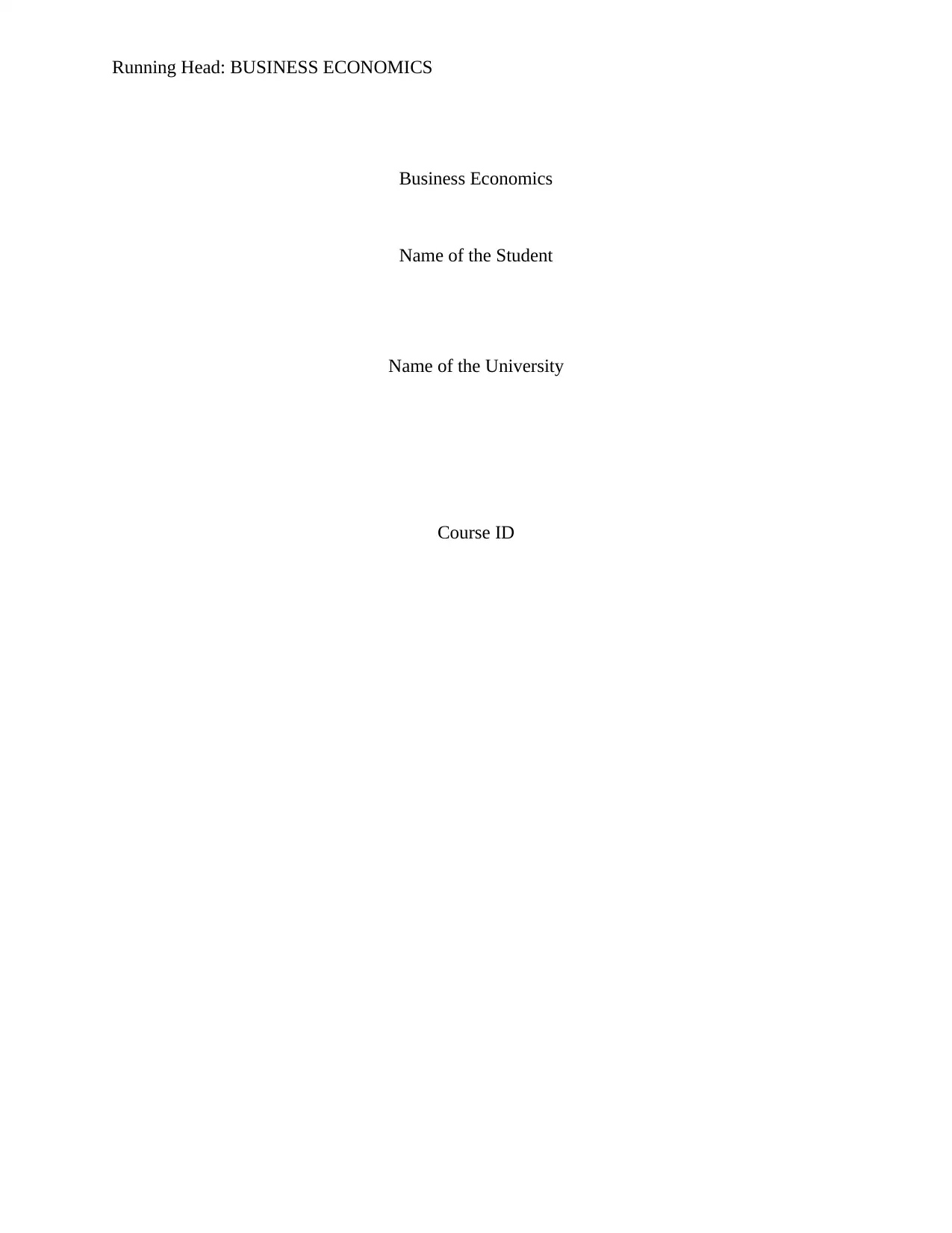
Running Head: BUSINESS ECONOMICS
Business Economics
Name of the Student
Name of the University
Course ID
Business Economics
Name of the Student
Name of the University
Course ID
Paraphrase This Document
Need a fresh take? Get an instant paraphrase of this document with our AI Paraphraser
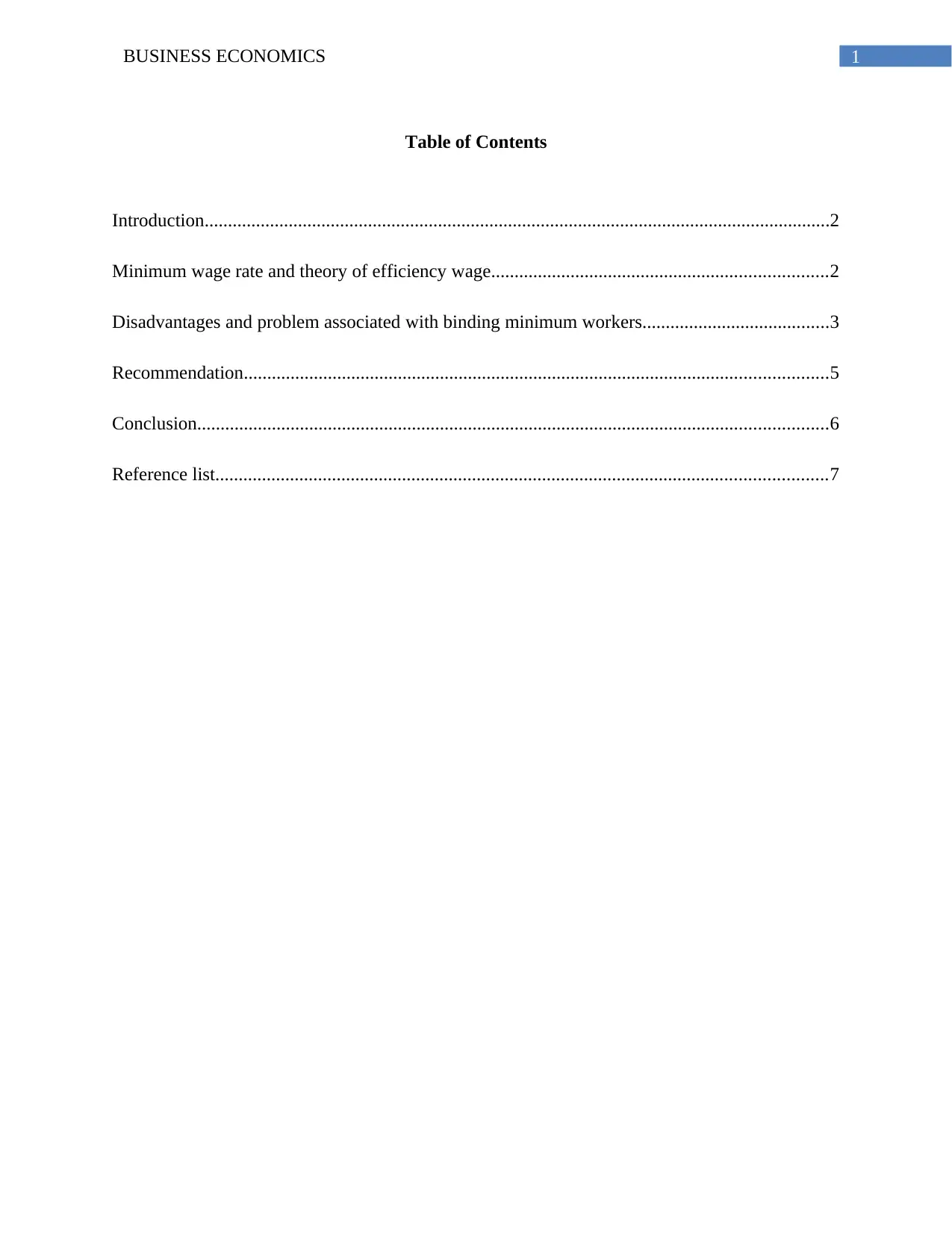
1BUSINESS ECONOMICS
Table of Contents
Introduction......................................................................................................................................2
Minimum wage rate and theory of efficiency wage........................................................................2
Disadvantages and problem associated with binding minimum workers........................................3
Recommendation.............................................................................................................................5
Conclusion.......................................................................................................................................6
Reference list...................................................................................................................................7
Table of Contents
Introduction......................................................................................................................................2
Minimum wage rate and theory of efficiency wage........................................................................2
Disadvantages and problem associated with binding minimum workers........................................3
Recommendation.............................................................................................................................5
Conclusion.......................................................................................................................................6
Reference list...................................................................................................................................7
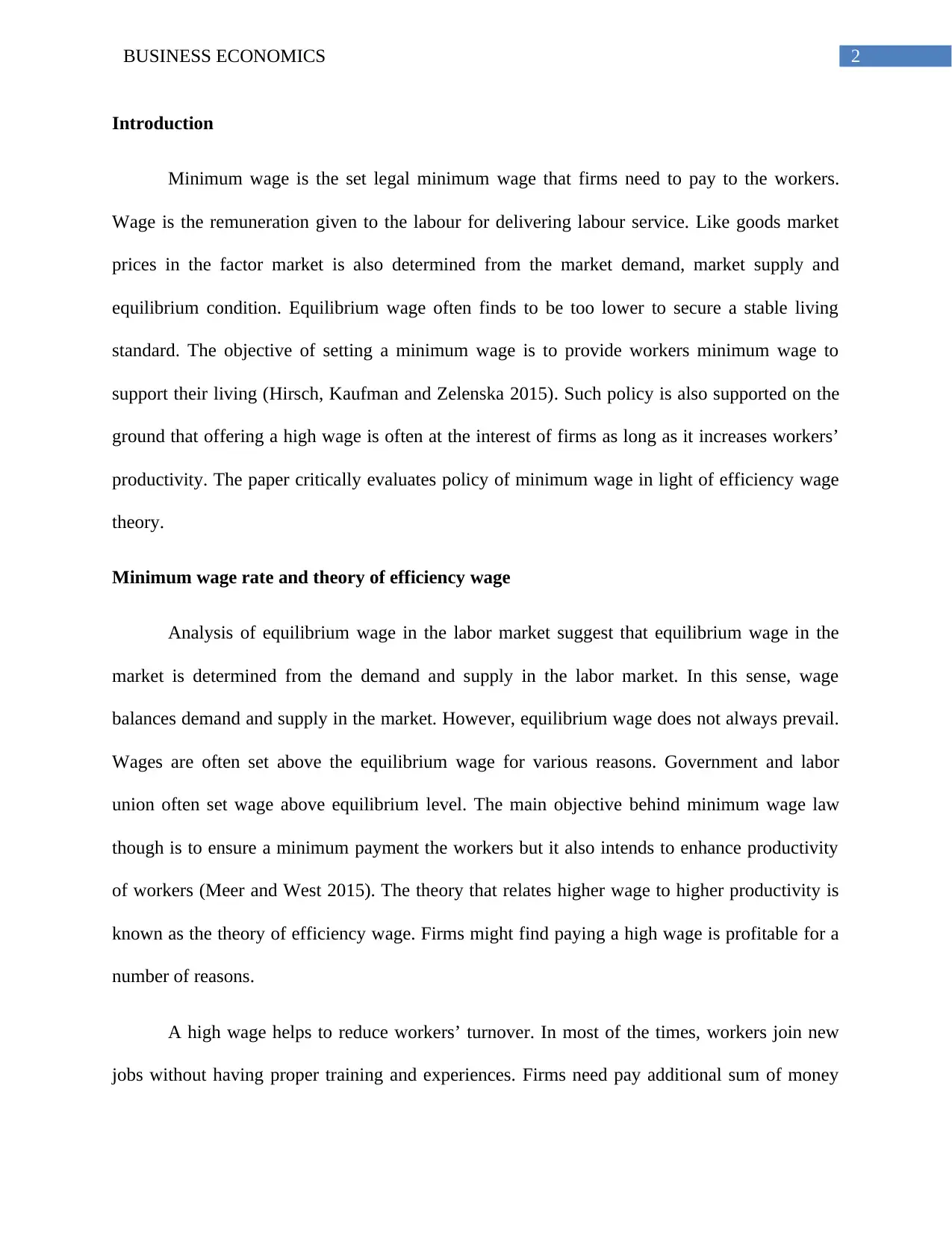
2BUSINESS ECONOMICS
Introduction
Minimum wage is the set legal minimum wage that firms need to pay to the workers.
Wage is the remuneration given to the labour for delivering labour service. Like goods market
prices in the factor market is also determined from the market demand, market supply and
equilibrium condition. Equilibrium wage often finds to be too lower to secure a stable living
standard. The objective of setting a minimum wage is to provide workers minimum wage to
support their living (Hirsch, Kaufman and Zelenska 2015). Such policy is also supported on the
ground that offering a high wage is often at the interest of firms as long as it increases workers’
productivity. The paper critically evaluates policy of minimum wage in light of efficiency wage
theory.
Minimum wage rate and theory of efficiency wage
Analysis of equilibrium wage in the labor market suggest that equilibrium wage in the
market is determined from the demand and supply in the labor market. In this sense, wage
balances demand and supply in the market. However, equilibrium wage does not always prevail.
Wages are often set above the equilibrium wage for various reasons. Government and labor
union often set wage above equilibrium level. The main objective behind minimum wage law
though is to ensure a minimum payment the workers but it also intends to enhance productivity
of workers (Meer and West 2015). The theory that relates higher wage to higher productivity is
known as the theory of efficiency wage. Firms might find paying a high wage is profitable for a
number of reasons.
A high wage helps to reduce workers’ turnover. In most of the times, workers join new
jobs without having proper training and experiences. Firms need pay additional sum of money
Introduction
Minimum wage is the set legal minimum wage that firms need to pay to the workers.
Wage is the remuneration given to the labour for delivering labour service. Like goods market
prices in the factor market is also determined from the market demand, market supply and
equilibrium condition. Equilibrium wage often finds to be too lower to secure a stable living
standard. The objective of setting a minimum wage is to provide workers minimum wage to
support their living (Hirsch, Kaufman and Zelenska 2015). Such policy is also supported on the
ground that offering a high wage is often at the interest of firms as long as it increases workers’
productivity. The paper critically evaluates policy of minimum wage in light of efficiency wage
theory.
Minimum wage rate and theory of efficiency wage
Analysis of equilibrium wage in the labor market suggest that equilibrium wage in the
market is determined from the demand and supply in the labor market. In this sense, wage
balances demand and supply in the market. However, equilibrium wage does not always prevail.
Wages are often set above the equilibrium wage for various reasons. Government and labor
union often set wage above equilibrium level. The main objective behind minimum wage law
though is to ensure a minimum payment the workers but it also intends to enhance productivity
of workers (Meer and West 2015). The theory that relates higher wage to higher productivity is
known as the theory of efficiency wage. Firms might find paying a high wage is profitable for a
number of reasons.
A high wage helps to reduce workers’ turnover. In most of the times, workers join new
jobs without having proper training and experiences. Firms need pay additional sum of money
⊘ This is a preview!⊘
Do you want full access?
Subscribe today to unlock all pages.

Trusted by 1+ million students worldwide
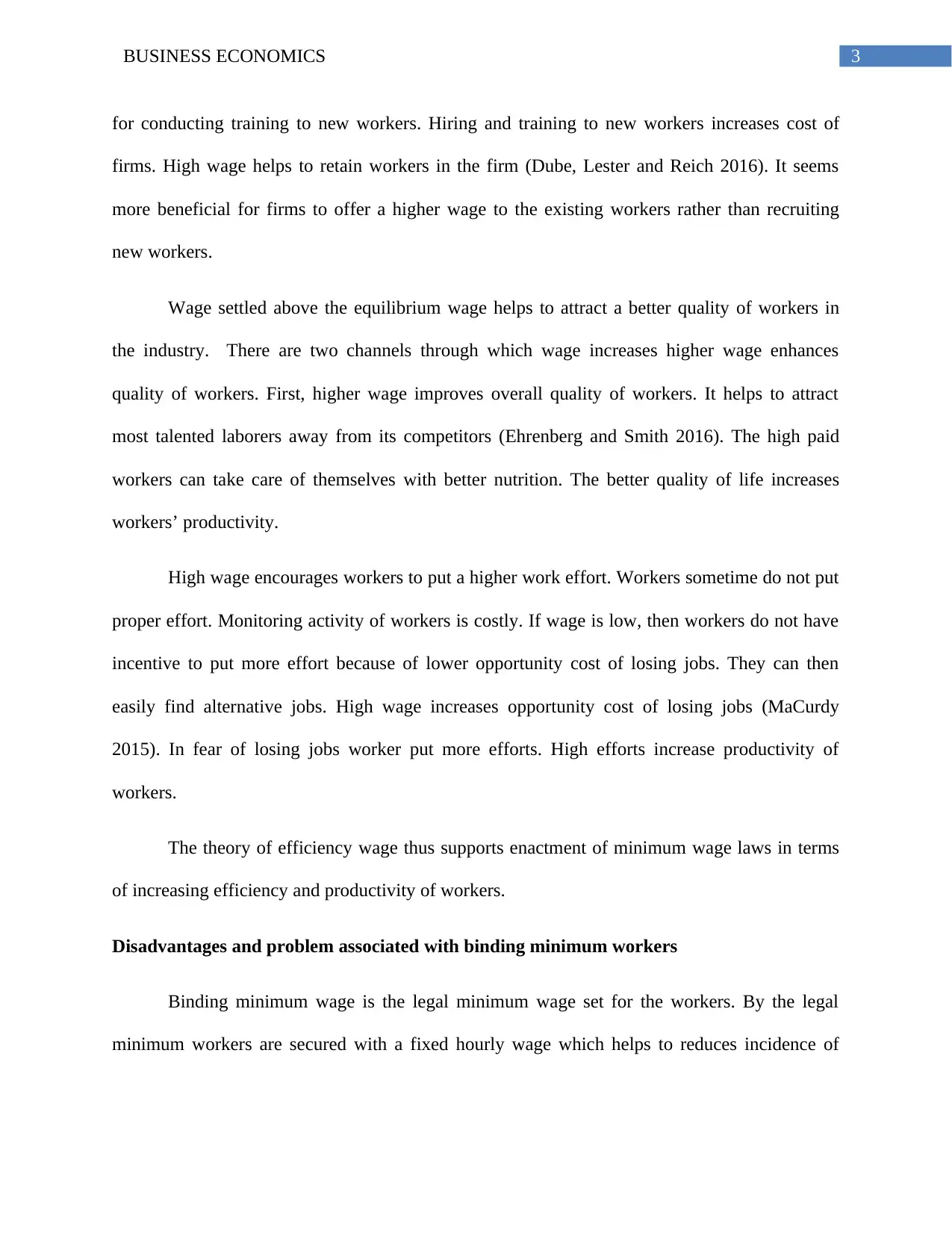
3BUSINESS ECONOMICS
for conducting training to new workers. Hiring and training to new workers increases cost of
firms. High wage helps to retain workers in the firm (Dube, Lester and Reich 2016). It seems
more beneficial for firms to offer a higher wage to the existing workers rather than recruiting
new workers.
Wage settled above the equilibrium wage helps to attract a better quality of workers in
the industry. There are two channels through which wage increases higher wage enhances
quality of workers. First, higher wage improves overall quality of workers. It helps to attract
most talented laborers away from its competitors (Ehrenberg and Smith 2016). The high paid
workers can take care of themselves with better nutrition. The better quality of life increases
workers’ productivity.
High wage encourages workers to put a higher work effort. Workers sometime do not put
proper effort. Monitoring activity of workers is costly. If wage is low, then workers do not have
incentive to put more effort because of lower opportunity cost of losing jobs. They can then
easily find alternative jobs. High wage increases opportunity cost of losing jobs (MaCurdy
2015). In fear of losing jobs worker put more efforts. High efforts increase productivity of
workers.
The theory of efficiency wage thus supports enactment of minimum wage laws in terms
of increasing efficiency and productivity of workers.
Disadvantages and problem associated with binding minimum workers
Binding minimum wage is the legal minimum wage set for the workers. By the legal
minimum workers are secured with a fixed hourly wage which helps to reduces incidence of
for conducting training to new workers. Hiring and training to new workers increases cost of
firms. High wage helps to retain workers in the firm (Dube, Lester and Reich 2016). It seems
more beneficial for firms to offer a higher wage to the existing workers rather than recruiting
new workers.
Wage settled above the equilibrium wage helps to attract a better quality of workers in
the industry. There are two channels through which wage increases higher wage enhances
quality of workers. First, higher wage improves overall quality of workers. It helps to attract
most talented laborers away from its competitors (Ehrenberg and Smith 2016). The high paid
workers can take care of themselves with better nutrition. The better quality of life increases
workers’ productivity.
High wage encourages workers to put a higher work effort. Workers sometime do not put
proper effort. Monitoring activity of workers is costly. If wage is low, then workers do not have
incentive to put more effort because of lower opportunity cost of losing jobs. They can then
easily find alternative jobs. High wage increases opportunity cost of losing jobs (MaCurdy
2015). In fear of losing jobs worker put more efforts. High efforts increase productivity of
workers.
The theory of efficiency wage thus supports enactment of minimum wage laws in terms
of increasing efficiency and productivity of workers.
Disadvantages and problem associated with binding minimum workers
Binding minimum wage is the legal minimum wage set for the workers. By the legal
minimum workers are secured with a fixed hourly wage which helps to reduces incidence of
Paraphrase This Document
Need a fresh take? Get an instant paraphrase of this document with our AI Paraphraser
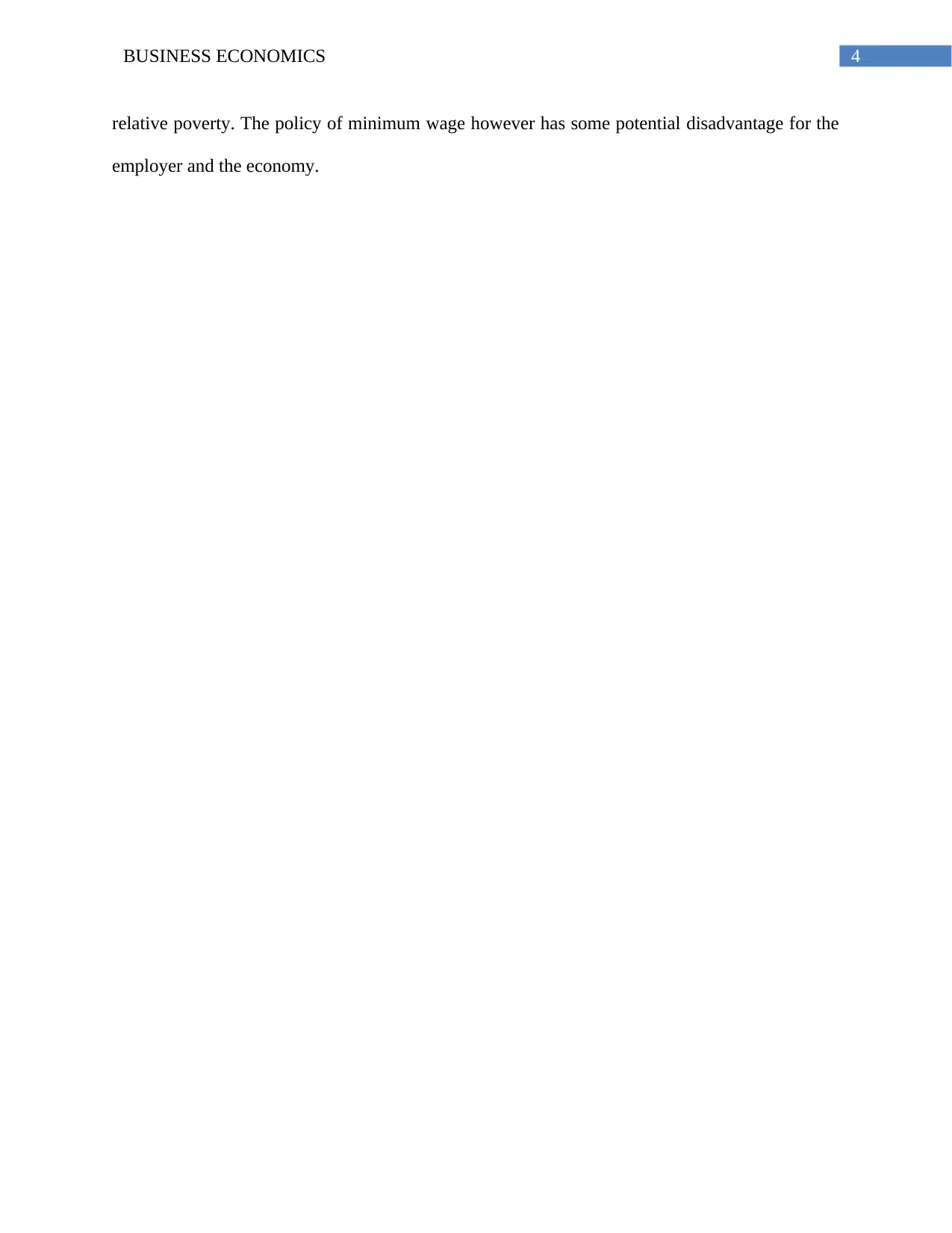
4BUSINESS ECONOMICS
relative poverty. The policy of minimum wage however has some potential disadvantage for the
employer and the economy.
relative poverty. The policy of minimum wage however has some potential disadvantage for the
employer and the economy.

5BUSINESS ECONOMICS
Unemployment
The first and foremost adverse consequence of minimum wage is on the unemployment
of the economy. Minimum wage indicates a disequilibrium position in the labor market. At the
higher wage, supply of workers exceed that of the demand (Addison, Blackburn and Cotti 2015).
The excess supply of workers results in unemployment.
Figure 1: Minimum wage and unemployment
(Source: as created by Author)
The figure above describes labor market consequences of minimum wage. Initial equilibrium in
the labor market is E obtained from intersection of labor demand (DD) and labor supply (SS).
The equilibrium wage in the market is W*. At this wage, L1 number of labors are employed in
the labor market. Now suppose, the legal minimum wage is set at W1. The high wage encourages
more workers to join the labor force. Supply of available labor increases to L3. Because of higher
Unemployment
The first and foremost adverse consequence of minimum wage is on the unemployment
of the economy. Minimum wage indicates a disequilibrium position in the labor market. At the
higher wage, supply of workers exceed that of the demand (Addison, Blackburn and Cotti 2015).
The excess supply of workers results in unemployment.
Figure 1: Minimum wage and unemployment
(Source: as created by Author)
The figure above describes labor market consequences of minimum wage. Initial equilibrium in
the labor market is E obtained from intersection of labor demand (DD) and labor supply (SS).
The equilibrium wage in the market is W*. At this wage, L1 number of labors are employed in
the labor market. Now suppose, the legal minimum wage is set at W1. The high wage encourages
more workers to join the labor force. Supply of available labor increases to L3. Because of higher
⊘ This is a preview!⊘
Do you want full access?
Subscribe today to unlock all pages.

Trusted by 1+ million students worldwide
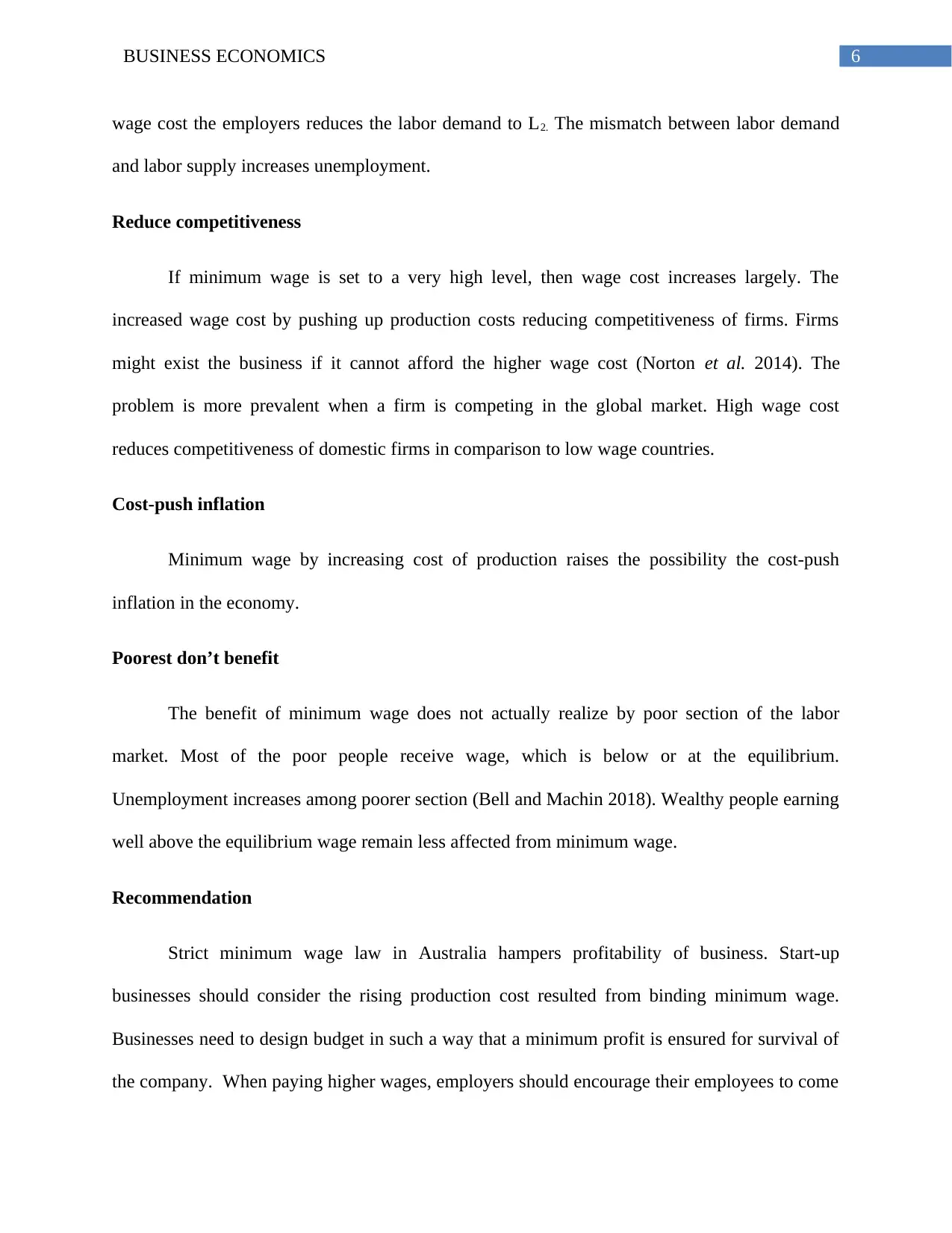
6BUSINESS ECONOMICS
wage cost the employers reduces the labor demand to L2. The mismatch between labor demand
and labor supply increases unemployment.
Reduce competitiveness
If minimum wage is set to a very high level, then wage cost increases largely. The
increased wage cost by pushing up production costs reducing competitiveness of firms. Firms
might exist the business if it cannot afford the higher wage cost (Norton et al. 2014). The
problem is more prevalent when a firm is competing in the global market. High wage cost
reduces competitiveness of domestic firms in comparison to low wage countries.
Cost-push inflation
Minimum wage by increasing cost of production raises the possibility the cost-push
inflation in the economy.
Poorest don’t benefit
The benefit of minimum wage does not actually realize by poor section of the labor
market. Most of the poor people receive wage, which is below or at the equilibrium.
Unemployment increases among poorer section (Bell and Machin 2018). Wealthy people earning
well above the equilibrium wage remain less affected from minimum wage.
Recommendation
Strict minimum wage law in Australia hampers profitability of business. Start-up
businesses should consider the rising production cost resulted from binding minimum wage.
Businesses need to design budget in such a way that a minimum profit is ensured for survival of
the company. When paying higher wages, employers should encourage their employees to come
wage cost the employers reduces the labor demand to L2. The mismatch between labor demand
and labor supply increases unemployment.
Reduce competitiveness
If minimum wage is set to a very high level, then wage cost increases largely. The
increased wage cost by pushing up production costs reducing competitiveness of firms. Firms
might exist the business if it cannot afford the higher wage cost (Norton et al. 2014). The
problem is more prevalent when a firm is competing in the global market. High wage cost
reduces competitiveness of domestic firms in comparison to low wage countries.
Cost-push inflation
Minimum wage by increasing cost of production raises the possibility the cost-push
inflation in the economy.
Poorest don’t benefit
The benefit of minimum wage does not actually realize by poor section of the labor
market. Most of the poor people receive wage, which is below or at the equilibrium.
Unemployment increases among poorer section (Bell and Machin 2018). Wealthy people earning
well above the equilibrium wage remain less affected from minimum wage.
Recommendation
Strict minimum wage law in Australia hampers profitability of business. Start-up
businesses should consider the rising production cost resulted from binding minimum wage.
Businesses need to design budget in such a way that a minimum profit is ensured for survival of
the company. When paying higher wages, employers should encourage their employees to come
Paraphrase This Document
Need a fresh take? Get an instant paraphrase of this document with our AI Paraphraser
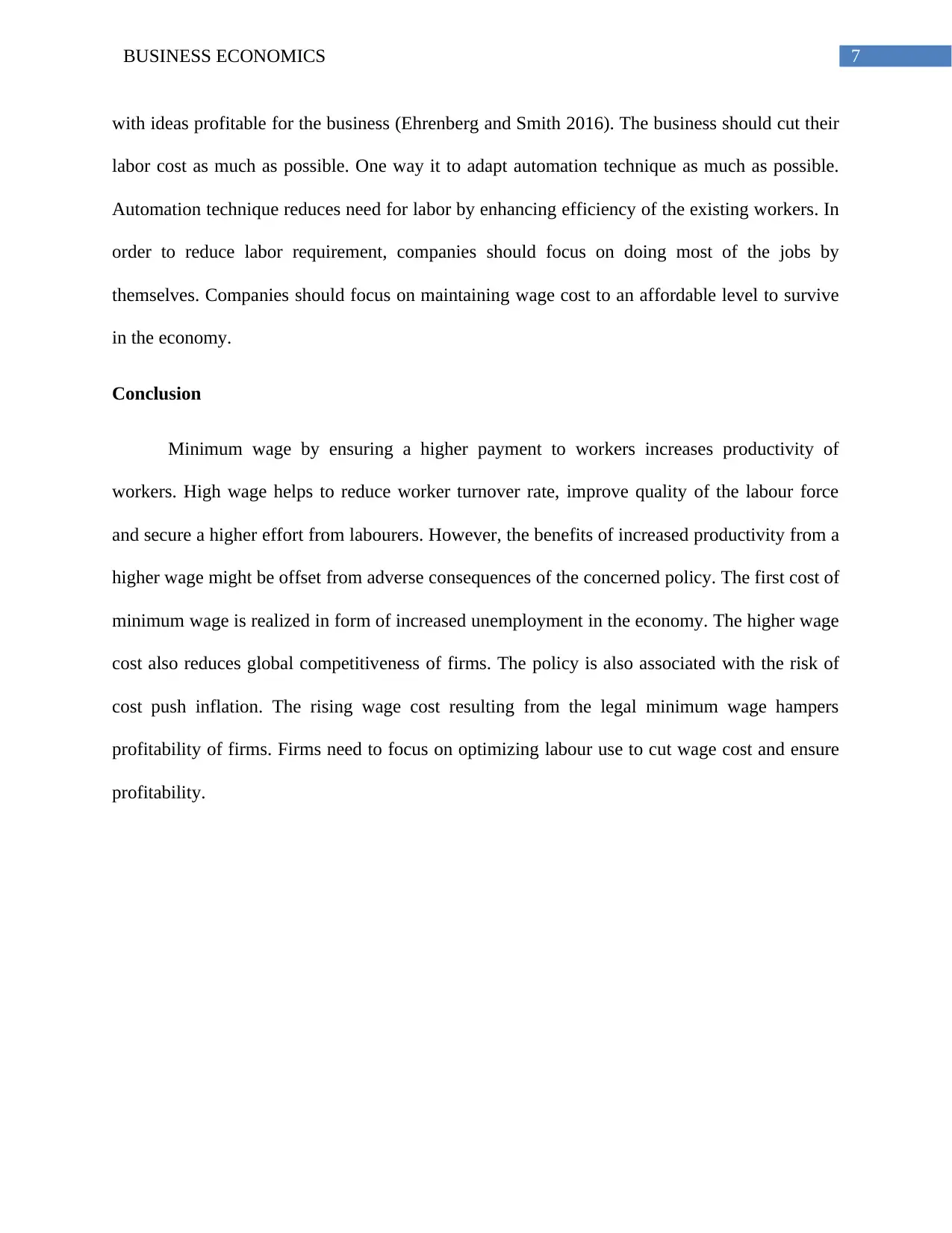
7BUSINESS ECONOMICS
with ideas profitable for the business (Ehrenberg and Smith 2016). The business should cut their
labor cost as much as possible. One way it to adapt automation technique as much as possible.
Automation technique reduces need for labor by enhancing efficiency of the existing workers. In
order to reduce labor requirement, companies should focus on doing most of the jobs by
themselves. Companies should focus on maintaining wage cost to an affordable level to survive
in the economy.
Conclusion
Minimum wage by ensuring a higher payment to workers increases productivity of
workers. High wage helps to reduce worker turnover rate, improve quality of the labour force
and secure a higher effort from labourers. However, the benefits of increased productivity from a
higher wage might be offset from adverse consequences of the concerned policy. The first cost of
minimum wage is realized in form of increased unemployment in the economy. The higher wage
cost also reduces global competitiveness of firms. The policy is also associated with the risk of
cost push inflation. The rising wage cost resulting from the legal minimum wage hampers
profitability of firms. Firms need to focus on optimizing labour use to cut wage cost and ensure
profitability.
with ideas profitable for the business (Ehrenberg and Smith 2016). The business should cut their
labor cost as much as possible. One way it to adapt automation technique as much as possible.
Automation technique reduces need for labor by enhancing efficiency of the existing workers. In
order to reduce labor requirement, companies should focus on doing most of the jobs by
themselves. Companies should focus on maintaining wage cost to an affordable level to survive
in the economy.
Conclusion
Minimum wage by ensuring a higher payment to workers increases productivity of
workers. High wage helps to reduce worker turnover rate, improve quality of the labour force
and secure a higher effort from labourers. However, the benefits of increased productivity from a
higher wage might be offset from adverse consequences of the concerned policy. The first cost of
minimum wage is realized in form of increased unemployment in the economy. The higher wage
cost also reduces global competitiveness of firms. The policy is also associated with the risk of
cost push inflation. The rising wage cost resulting from the legal minimum wage hampers
profitability of firms. Firms need to focus on optimizing labour use to cut wage cost and ensure
profitability.
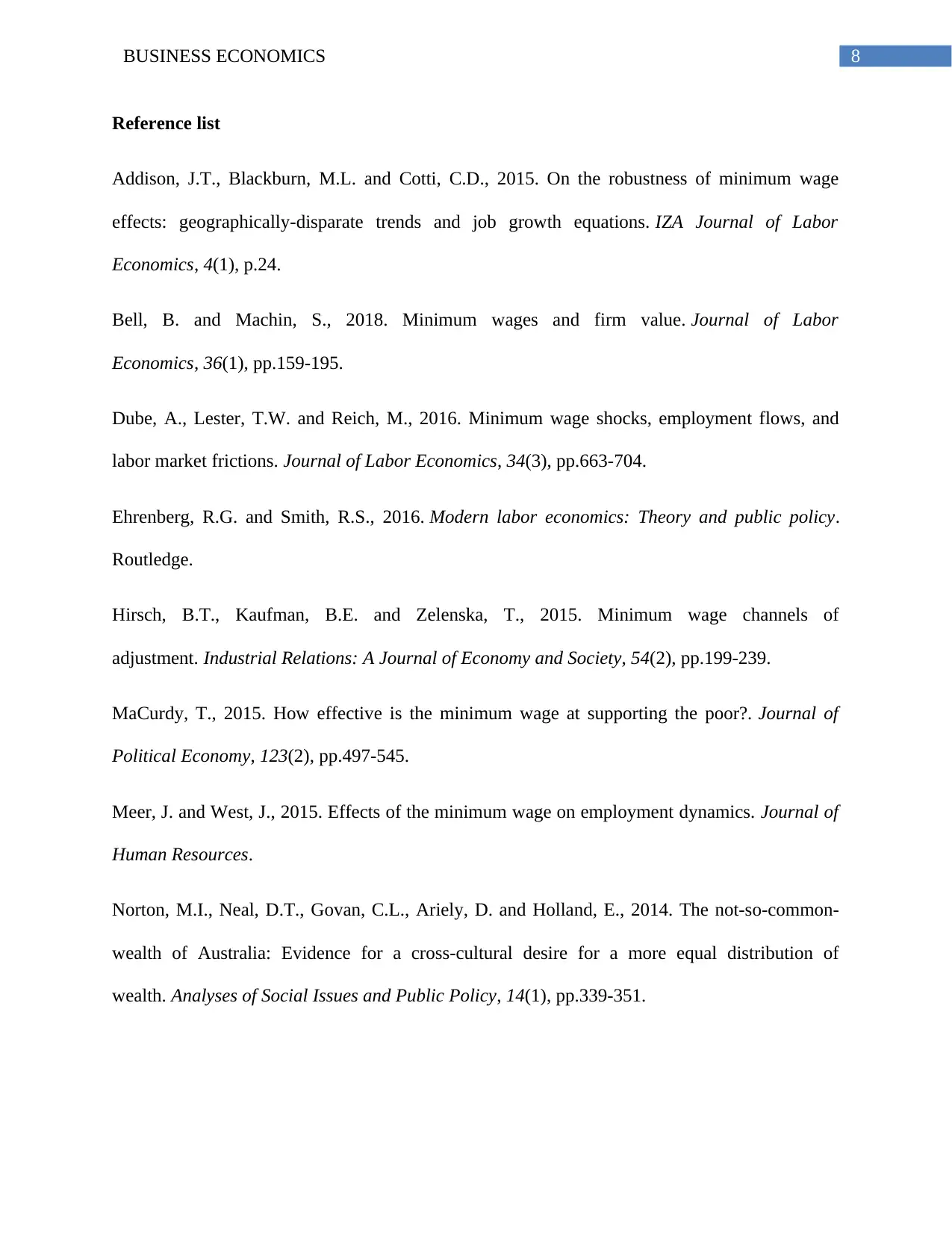
8BUSINESS ECONOMICS
Reference list
Addison, J.T., Blackburn, M.L. and Cotti, C.D., 2015. On the robustness of minimum wage
effects: geographically-disparate trends and job growth equations. IZA Journal of Labor
Economics, 4(1), p.24.
Bell, B. and Machin, S., 2018. Minimum wages and firm value. Journal of Labor
Economics, 36(1), pp.159-195.
Dube, A., Lester, T.W. and Reich, M., 2016. Minimum wage shocks, employment flows, and
labor market frictions. Journal of Labor Economics, 34(3), pp.663-704.
Ehrenberg, R.G. and Smith, R.S., 2016. Modern labor economics: Theory and public policy.
Routledge.
Hirsch, B.T., Kaufman, B.E. and Zelenska, T., 2015. Minimum wage channels of
adjustment. Industrial Relations: A Journal of Economy and Society, 54(2), pp.199-239.
MaCurdy, T., 2015. How effective is the minimum wage at supporting the poor?. Journal of
Political Economy, 123(2), pp.497-545.
Meer, J. and West, J., 2015. Effects of the minimum wage on employment dynamics. Journal of
Human Resources.
Norton, M.I., Neal, D.T., Govan, C.L., Ariely, D. and Holland, E., 2014. The not‐so‐common‐
wealth of Australia: Evidence for a cross‐cultural desire for a more equal distribution of
wealth. Analyses of Social Issues and Public Policy, 14(1), pp.339-351.
Reference list
Addison, J.T., Blackburn, M.L. and Cotti, C.D., 2015. On the robustness of minimum wage
effects: geographically-disparate trends and job growth equations. IZA Journal of Labor
Economics, 4(1), p.24.
Bell, B. and Machin, S., 2018. Minimum wages and firm value. Journal of Labor
Economics, 36(1), pp.159-195.
Dube, A., Lester, T.W. and Reich, M., 2016. Minimum wage shocks, employment flows, and
labor market frictions. Journal of Labor Economics, 34(3), pp.663-704.
Ehrenberg, R.G. and Smith, R.S., 2016. Modern labor economics: Theory and public policy.
Routledge.
Hirsch, B.T., Kaufman, B.E. and Zelenska, T., 2015. Minimum wage channels of
adjustment. Industrial Relations: A Journal of Economy and Society, 54(2), pp.199-239.
MaCurdy, T., 2015. How effective is the minimum wage at supporting the poor?. Journal of
Political Economy, 123(2), pp.497-545.
Meer, J. and West, J., 2015. Effects of the minimum wage on employment dynamics. Journal of
Human Resources.
Norton, M.I., Neal, D.T., Govan, C.L., Ariely, D. and Holland, E., 2014. The not‐so‐common‐
wealth of Australia: Evidence for a cross‐cultural desire for a more equal distribution of
wealth. Analyses of Social Issues and Public Policy, 14(1), pp.339-351.
⊘ This is a preview!⊘
Do you want full access?
Subscribe today to unlock all pages.

Trusted by 1+ million students worldwide
1 out of 9
Related Documents
Your All-in-One AI-Powered Toolkit for Academic Success.
+13062052269
info@desklib.com
Available 24*7 on WhatsApp / Email
![[object Object]](/_next/static/media/star-bottom.7253800d.svg)
Unlock your academic potential
Copyright © 2020–2025 A2Z Services. All Rights Reserved. Developed and managed by ZUCOL.





